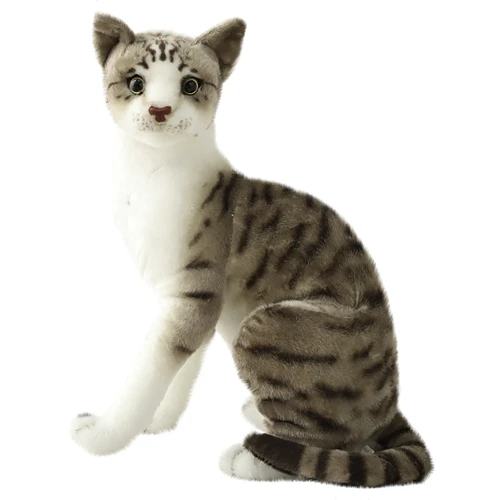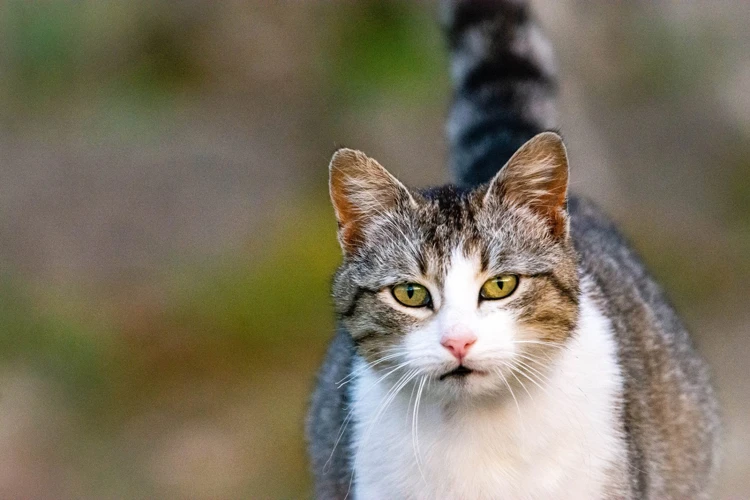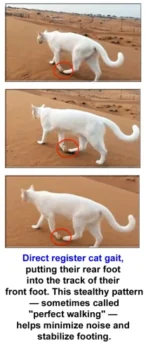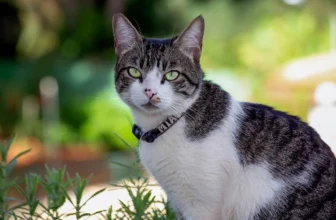As a wirehair cat owner, it can be an exciting and overwhelming experience when your furry friend becomes pregnant. Understanding the pregnancy stages and being able to recognize the signs and symptoms can help you provide better care for your pregnant cat and her newborn kittens. In this guide, we will explore the physical and behavioral changes to look out for during wirehair pregnancy, the different stages of pregnancy, and postpartum care for both mother and kittens. So, let’s dive into this journey of understanding wirehair pregnancy stages and ensure the well-being of your cat and her kittens.
Signs and Symptoms of Wirehair Pregnancy

As a cat owner, it is important to understand the signs and symptoms of wirehair pregnancy to ensure that your furry friend is healthy throughout the process. Wirehair cats are known for their unique appearance and independent personalities, but when it comes to pregnancy, they may require extra attention and care. It is essential to keep an eye on physical and behavioral changes that may indicate pregnancy. In this article, we will explore the various signs and symptoms of wirehair pregnancy that cat owners should look out for. Additionally, we will provide helpful tips on how to ensure that both mother and kittens stay healthy throughout the pregnancy. If you are interested in learning more about wirehair pregnancy and how to care for your pregnant cat, read on! Don’t forget to check our breeding guide to make sure you are doing it responsibly and check the health issues that can arise.
Physical Changes
During pregnancy, a wirehair cat’s body undergoes various physical changes that are necessary for the growth and development of her litter. Understanding these changes can help cat owners provide better care for their pregnant pets. Here are some of the common physical changes that occur during wirehair pregnancy:
| Physical Changes | Description |
|---|---|
| Enlarged Abdomen | As the kittens grow, the wirehair’s belly will become noticeably larger. This is one of the obvious signs of pregnancy. |
| Nipple Changes | The cat’s nipples will become enlarged, pinker, and more prominent, as they prepare to nurse the kittens. |
| Weight Gain | A pregnant wirehair may gain 2-4 pounds throughout her pregnancy, with the majority of this weight gain occurring in the second half of gestation. |
| Increased Appetite | The cat may start to eat more than usual, as her body requires more nutrients to support the growing fetuses. Providing high-quality, nutritionally balanced food is essential during this time. |
| Vomiting | Some wirehairs experience morning sickness during the first few weeks of pregnancy, which may manifest as vomiting or reduced appetite. Owners should consult with their veterinarian if the vomiting persists or is severe. |
| Changes in Coat | Some wirehairs may experience changes in their coat during pregnancy, such as increased shedding or a duller appearance. This is normal and usually resolves after delivery. |
In addition to these physical changes, it is important for wirehair owners to monitor their cats for any health issues that may arise during pregnancy. Regular vet check-ups and monitoring for signs of complications are essential. For more information on wirehair pregnancy health issues, check out our FAQ page.
By keeping an eye out for these physical changes and staying proactive about your cat’s healthcare needs, owners can promote a healthy and happy pregnancy for their wirehair pets. For more information on wirehair kitten care, check out our Kitten Checklist.
Behavioral Changes
During pregnancy, wirehair cats can exhibit various behavioral changes due to hormonal fluctuations. These behavioral changes are normal and can be expected as a part of the pregnancy process. Some common behavioral changes that wirehair cat owners may notice include:
- Increased affection: Your usually aloof wirehair might become more affectionate during pregnancy. Expect more cuddles and head-butts than usual.
- Vocalization: Pregnant cats can become more vocal, meowing more frequently than usual. This behavior may begin during the earlier stages of pregnancy and continue until delivery.
- Changes in Appetite: Pregnant wirehairs may have a decrease or increase in their appetite. It is important to ensure that she is getting proper nutrition during this time. Speak to your veterinarian about any concerns in this regard and follow their advice accordingly.
- Nesting: A pregnant wirehair’s instinct to prepare for birth often involves a search for a suitable place to give birth. She may begin nesting – carrying soft items to a selected location and bedding down there. Be attentive to this behavior and provide a suitable, quiet and private place for her to give birth.
- Agitation: A pregnant wirehair may become easily agitated towards other pets or family members. She may want more alone time and could get irritated by something as simple as too much noise in the house. This behavior is normal and can be managed by giving her space, keeping the environment calm and peaceful.
It is important to understand that these changes are normal as it is a part of the pregnancy journey. Observe these behavioral changes and communicate with a veterinarian if any seem extreme or are a concern. Understanding a wirehair cat’s behavioral changes is a crucial part of being a responsible pet owner.
For more tips on caring for pregnant wirehairs, check out our article on feeding pregnant Wirehairs. It’s always important to breed wirehairs responsibly. Check out our article on breeding wirehairs responsibly to learn more.
Wirehair Pregnancy Stages

One of the most exciting moments for cat owners is when their furry friend enters the pregnancy stage. As a wirehair cat owner, it is essential to understand the different stages of pregnancy that your cat will go through. This will help you identify which stage they are in and take the necessary steps to ensure their proper care throughout the entire process. In this section, we will go through all four stages of wirehair pregnancy, from early pregnancy to labor and delivery, as well as important postpartum care tips for your cat and her kittens. Don’t miss out on these essential tips to ensure the health and well-being of your beloved feline family members.
Stage One: Early Pregnancy
During the first stage of wirehair pregnancy, the fertilized eggs travel through the fallopian tubes and into the uterus. This is where they will start to develop. During this stage, there may not be any noticeable physical changes. However, it is important to keep an eye out for signs of pregnancy such as a lack of interest in mating and increased appetite.
Signs of early wirehair pregnancy:
- Decreased activity and sleeping more than usual
- Increased appetite and potentially food fussiness
- Nipple darkening and enlargement
- Morning sickness
Wirehairs may experience the equivalent of morning sickness during the early stages of pregnancy. They may also become more possessive or affectionate with their owners. It is important to increase the amount of food given to the wirehair during this stage and to avoid stressful situations.
Preparing for late pregnancy:
- Start feeding high-quality kitten food and provide fresh water at all times
- Consider getting your wirehair a bed with blankets
It is important to prepare for late-stage pregnancy during the early stages by ensuring the wirehair has proper nutrition and a comfortable place to give birth. It is also important to communicate with a veterinarian about the health of your pet for the best advice.
Monitoring the health of your Wirehair:
- Ensure your wirehair gets regular veterinary check-ups throughout pregnancy
- Welfare of the cat, such as avoiding neck pressure and entanglement with cables
Having regular check-ups with a veterinarian is crucial for a healthy pregnancy for the wirehair. Wiring or cables may be harmful to the wirehair if they become ensnared; such free-roaming items should be hidden from the cat’s reach. Also, it is important to refrain from putting pressure on their neck to avoid restricting any blood flow.
For proper preparation of wirehair pregnancy, ensure that you have enough information about late-stage pregnancy, labor, and delivery. You can find valuable information on such topics at wirhair labor delivery tips. Additionally, the mother wirehair and their kittens require special care and attention during the first few weeks after birth. Learn more about taking care of them at postpartum care wirehairs mom kittens.
Stage Two: Mid-Pregnancy
During the mid-pregnancy phase, which typically spans from days 21 to 45, your wirehair cat will experience several significant changes that are critical for the kittens’ proper growth and development. Here are some things to keep in mind during this stage:
- Fetal Development: By day 25, the fetal skeletons will start to calcify, and the fetuses will develop whisker buds, claws, and paw pads. At this stage, the kittens are still very fragile, so it’s crucial to maintain a calm environment to avoid any physical or emotional stress to the mother cat, which could potentially harm the developing fetuses.
- Weight Gain: As the fetuses grow rapidly, the mother cat’s overall weight will increase significantly. Typically, during mid-pregnancy, the cat’s weight will increase anywhere from 25% to 50% of its pre-pregnancy weight. However, it’s important to keep in mind that excessive weight gain can cause complications during delivery, so make sure to provide proper nutrition and limit overfeeding.
- Behavioral Changes: At this stage, the mother cat’s behavior may change significantly. She will likely become more affectionate and seek out a comfortable and quiet place to nest and rest. It’s essential to provide her with a clean and comfortable area, away from any noises or disruptions.
- Nutrition: During mid-pregnancy, nutrition is critical for the healthy development of the fetuses. The mother cat’s diet should include high-quality protein sources, such as chicken or fish, and it’s recommended to add supplements of vitamins and minerals to support both her and the fetuses. Consult with your veterinarian to determine the right diet for your cat.
It’s important to monitor your wirehair cat closely throughout the mid-pregnancy stage and look out for any signs of potential complications, such as vaginal discharge, lack of appetite, or unusual behaviors. Regular vet checkups can also help ensure the health and well-being of both the mother cat and her developing fetuses.
Stage Three: Late Pregnancy
During the late pregnancy stage, your wirehair cat will experience significant changes, both physically and behaviorally. This stage usually begins around the eight-week mark, and it’s crucial to pay extra attention to your cat’s health and ensure she’s comfortable.
Physical Changes:
During late pregnancy, your wirehair cat’s abdomen will become visibly larger. Her mammary glands will also become more prominent, and you’ll be able to feel the kittens moving inside her belly. As the delivery date draws closer, you may notice your cat’s breathing becoming more labored, and she may start nesting in a particular spot.
It’s important to exercise caution during this stage. Don’t handle your cat too much, as this could cause stress and complications. Make sure she has a quiet, comfortable place to rest, and provide her with plenty of fresh water and food.
Behavioral Changes:
During late pregnancy, your wirehair cat’s behavior may become more erratic. She may start to become more restless, meow more frequently, and seek out a quiet, secluded spot to nest in. Some cats may become more affectionate, while others may withdraw and become aggressive or defensive.
It’s essential to observe your cat’s behavior carefully during this stage. If you notice any significant changes, such as a decrease in appetite or excessive crying, it’s crucial to contact your veterinarian immediately.
Here is a table summarizing the physical and behavioral changes that typically occur during the late pregnancy stage:
| Physical Changes: | Behavioral Changes: |
|---|---|
| Visible increase in abdominal size | Restlessness and seeking out a quiet nesting spot |
| Prominent mammary glands | Increased meowing |
| Movement of kittens can be felt | Erratic behavior, potentially more aggressive or clingy |
Taking proper care of your wirehair cat during the late pregnancy stage is vital to ensure a smooth delivery and healthy kittens. Keep a close eye on your cat’s behavior and health, and be sure to contact your veterinarian if you notice any concerning changes.
Stage Four: Labor and Delivery
During the fourth stage of wirehair pregnancy—labor and delivery, the mother wirehair will begin to exhibit signs that she is ready to give birth to her kittens. It is important that cat owners be aware of these signs and be prepared to assist their pets during this stage.
Signs of Approaching Labor
The first sign that a mother wirehair is about to give birth is nesting behavior. She will start looking for a safe and comfortable place to give birth, such as a cardboard box filled with blankets or towels. During this stage, it is crucial to provide her with a quiet and safe area where she can give birth undisturbed.
The second sign that a mother wirehair is about to give birth is a substantial drop in body temperature, which can decrease up to a couple of degrees. This often occurs 12 to 24 hours before labor starts.
Labor and Delivery
The onset of labor is marked by contractions. The mother wirehair may exhibit signs such as panting, vocalizing, and pacing. She may also have a discharge from her vagina. During labor, it is important to provide the mother wirehair with a calm and soothing environment.
Once the first kitten is out, the mother wirehair will break the amniotic sac and lick the kitten to clean it and stimulate its breathing. If the mother wirehair does not lick her kitten immediately, you should step in and assist by gently rubbing the kitten with a clean towel.
After the kitten has been cleaned, the mother wirehair will eat the placenta. This is a natural process, and it provides the mother wirehair with nutrients and helps prevent predators from detecting the scent of the newborns.
The entire labor and delivery process will typically last between 2 to 6 hours. If the delivery process extends longer, or if the mother wirehair seems to be in distress and not passing kittens for an extended period, it may be necessary to contact a veterinarian to seek medical intervention.
During labor and immediately after, provide the mother cat with enough food and water to help her recover quickly. Also, ensure that the area where the mother cat and her kittens are is warm and quiet.
Table 1: Checklist for Labor and Delivery
| Task | Description |
|---|---|
| Create a Safe and Calm Space | Prepare an area that is warm, quiet, and conveniently located. |
| Monitor Behavior | Watch for behavioral signs such as nesting and contractions, and track the timing and frequency of contractions. |
| Assist with Cleaning | If the mother wirehair does not clean her kitten immediately after birth, use a clean towel to rub the kitten and stimulate its breathing. |
| Provide Nutrition and Hydration | Provide the mother wirehair with enough food and water to help her recover quickly and keep her energy up. |
| Seek Medical Intervention | If the labor and delivery process extends longer than 6 hours or if the mother wirehair is in distress, contact a veterinarian for medical intervention. |
Following the birth of her kittens, the mother wirehair will be busy caring for her offspring. It is essential to provide round-the-clock care for the mother as well as the kittens to ensure that they are healthy and thriving.
Postpartum Care
Welcoming a new litter of kittens into the world is a joyous occasion for any cat owner. However, once the kittens are born, it’s crucial to provide proper postpartum care for both the mother cat and her newborns. This stage requires dedicated attention and care from you as an owner. From feeding and cleaning to monitoring the health of the mother cat and her kittens, proper postpartum care is vital to ensure a healthy and happy litter. Let’s explore some of the essential aspects of postpartum care for your wirehair cat and her kittens.
Caring for Newborn Kittens
Newborn kittens are fragile and require a lot of care to ensure they grow up healthy. Here are some tips on how to care for newborn kittens:
| Feeding | During the first few weeks of their lives, kittens should be fed every two to three hours. They should be nursed by their mother if possible, or alternatively, you can bottle feed them with kitten milk replacer. Make sure to burp the kittens after each feeding to prevent them from getting gassy. |
| Keeping them warm | Newborn kittens cannot regulate their body temperature yet, so it’s important to keep them warm. Use a heating pad set on low or a heat lamp to provide a warm area for them to snuggle up in. Place a soft blanket or towel in their nesting area to provide additional warmth. |
| Stimulation | Kittens cannot eliminate waste on their own until they are about three weeks old. To help them, gently stimulate their genitals with a warm, damp cloth after each feeding. This will help them go to the bathroom. |
| Cleaning | During the first few weeks, it’s important to keep the kittens clean. Wipe their face and paws with a warm, damp cloth to remove any milk or dirt. If they get soiled with urine or feces, gently clean them with a damp cloth and dry them off with a towel. |
| Monitoring | Keep a close eye on the kittens to ensure they are growing and developing properly. They should be gaining weight each day and should be active and vocal. If you notice any signs of illness or weakness, contact your veterinarian immediately. |
Taking care of newborn kittens can be challenging, but with proper care and attention, they can grow up to be healthy and happy cats.
Caring for the Mother Cat
Once the mother cat has given birth, it is important to provide her with proper care to ensure her speedy recovery and the well-being of her kittens. Below are some key steps to follow when caring for the mother cat:
| Step | Description |
|---|---|
| Provide a Safe and Comfortable Environment | The mother cat should have a warm and cozy place to rest, away from any noises or distractions. A box with soft bedding is an ideal option. Make sure the area is clean and free of any hazards that could harm the mother and her kittens. |
| Monitor Her Health | It’s important to keep an eye on the mother cat’s health after giving birth. Watch for any signs of infection or complications, such as fever, loss of appetite, or discharge. Contact a veterinarian immediately if any concerns arise. |
| Provide Plenty of Nutritious Food and Water | The mother cat will need to eat more food than usual to produce milk for her kittens. Offer her high-quality food that is rich in nutrition and a lot of fresh water. Make sure she has easy access to both at all times. |
| Keep the Litter Box Clean | The mother cat will need to use the litter box regularly, so make sure it’s clean and easy for her to access. Use unscented litter that won’t irritate her sensitive nose and clean the litter box daily. |
| Limit Visitors | Since the mother cat will be busy nursing and caring for her kittens, it’s best to limit visitors in the first few weeks after giving birth. This will help reduce stress on the mother and keep the kittens safe from potential harm. |
By following these steps, you can help ensure that the mother cat stays healthy and comfortable after giving birth, and that her kittens thrive under her care.
Weaning the Kittens
When the kittens reach about four weeks of age, they will begin to show interest in solid foods. This is an indication that it’s time to start the weaning process. Weaning is a gradual process that will take several weeks and requires patience and careful attention to the kittens’ needs. Here are some steps to follow when weaning your wirehair kittens:
- Introduce kitten food: Begin by introducing a small amount of wet kitten food mixed with kitten milk replacement formula in a shallow dish. Let the kittens explore and taste the food. They may play with it at first, but they will soon learn to eat it. Gradually increase the amount of food offered and decrease the amount of milk formula over time.
- Provide fresh water: Make sure to provide fresh water in a separate dish alongside the food. Clean and refill the water dish daily.
- Monitor their progress: Watch the kittens closely during meal times to make sure they are eating and drinking enough. Weaned kittens should eat at least four small meals a day, but they may need more if they are particularly active or larger in size.
- Discourage nursing: As the kittens get more comfortable with eating solid foods, they may try to nurse less. However, if the mother cat is still nursing, it’s important to discourage the kittens from nursing too much to prevent sore nipples or mastitis.
- Separate the mother cat: If the mother cat is particularly protective of her kittens, you may need to separate her from them during meal times to allow the kittens to eat without interference. However, make sure to give the mother cat plenty of quality time with her kittens outside of meal times.
- Gradually transition to dry food: Once the kittens are eating wet food consistently, you can start to transition them to dry kitten food by mixing a small amount of dry food into their wet food. Gradually increase the amount of dry food over the course of several days until they are eating only dry food.
Remember, always provide access to clean water and monitor their progress to ensure they are growing healthily. Consult with your veterinarian about the appropriate food and feeding schedules for your kittens. With patience and consistent care, you can successfully wean your wirehair kittens and prepare them for a healthy, independent life.
Conclusion
After reading through this comprehensive article, we hope that you have gained a better understanding of wirehair pregnancy stages and how to care for your pregnant cat. As a devoted pet owner, it’s important to recognize the signs and symptoms of wirehair pregnancy to ensure the health and well-being of your feline friend. Remember to provide your cat with plenty of affection, a nutritious diet, and regular veterinary check-ups to keep both the mother and her kittens healthy.
Once the kittens are born, it’s crucial to provide postpartum care to facilitate their growth and development. As we’ve discussed, caring for newborn kittens involves feeding them specialized kitten milk and monitoring their weight gain and overall health. Additionally, caring for the mother cat involves ensuring that she receives proper nutrition, rest, and medical attention to support her postpartum recovery.
Although the process of wirehair pregnancy and caring for newborn kittens can be daunting, with proper preparation and care it can be a rewarding and joyful experience. By following the guidelines outlined in this article, you can provide your wirehair cat with the care and attention she needs to thrive during pregnancy and beyond. Remember to seek help from your veterinarian or a professional breeder if you have any questions or concerns throughout the process. Best of luck to you and your furry family!
Frequently Asked Questions
1. Can a wirehair cat get pregnant during her first heat cycle?
Yes, wirehair cats can get pregnant during their first heat cycle which usually occurs when they are around six months old.
2. How long is the gestation period for wirehair cats?
The gestation period for wirehair cats is typically around 63-65 days.
3. Is it safe to spay a pregnant wirehair cat?
No, it is not recommended to spay a pregnant wirehair cat as it can be risky and may harm both the mother and the kittens.
4. Can a wirehair cat have multiple litters in one year?
It is possible for a wirehair cat to have multiple litters in one year, but it is not recommended as it can be taxing on the mother’s body and may cause health issues.
5. How many kittens can a wirehair cat have in a litter?
A wirehair cat can have anywhere from 1 to 8 kittens in a litter, with the average litter size being around 4 to 5 kittens.
6. Can wirehair cats go into labor at night?
Yes, wirehair cats can go into labor at any time, including at night.
7. How soon can you handle the newborn kittens?
It is recommended to wait at least a week before handling the newborn kittens as they are very fragile and can be easily injured.
8. How can you tell if a wirehair cat is in labor?
Signs that a wirehair cat is in labor include restlessness, panting, nesting behaviors, and contractions. She may also start vocalizing or licking her genital area.
9. Can you breed a mother wirehair cat with her son or daughter?
No, it is not recommended to breed a mother wirehair cat with her son or daughter as this can lead to genetic defects and health issues in the offspring.
10. How long does it take for wirehair kittens’ eyes to open?
Wirehair kittens’ eyes typically open around 7-10 days after birth, but it can vary depending on the kitten’s individual development.







